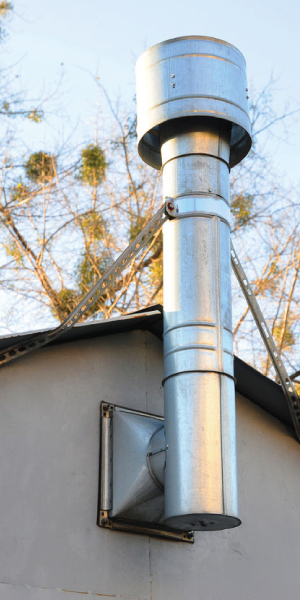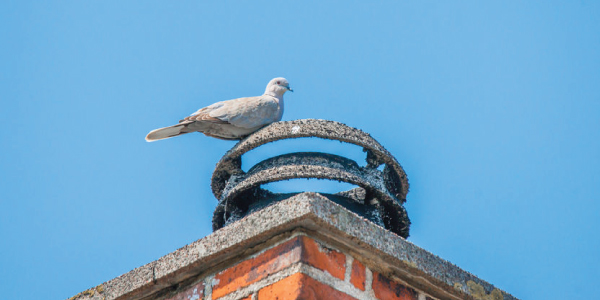
Are Chimney Caps Important?
Not every house with a chimney has a chimney cap fitted. And despite the fact that chimney caps aren’t very expensive, homeowners often neglect having one installed, believing they aren’t important to the overall function of the chimney.
However, if more homeowners knew the value of chimney caps, they wouldn’t be so reluctant about getting them. The relatively low investment of getting a chimney cap, could literally save thousands of dollars down the line.
Not quite sure whether getting a chimney cap is necessary? Here’s why you should have a chimney cap installed on your home this winter.

Keep Animals out of Your Chimney
Birds love to make their nest in your chimney. But birds aren’t even the only problem, small mammals such as raccoons and squirrels also like to investigate the space inside your chimney.
Animals are especially prone to making their home in your chimney during the cold of winter. That’s because the heat from your fireplace makes the chimney nice and warm, offering the little animals a welcoming space to build their nests. Generally it doesn’t even take too long for a squirrel or bird to build a nest in your chimney. Before you know it, your home will have some new inhabitants in the chimney!
But as you might have guessed already, the warm and cozy home your chimney offers won’t be comfortable for very long. As soon as you use your fireplace again, smoke and sparks will travel up your chimney, potentially killing the little animals who didn’t know any better than to make their home there. So obviously, getting a chimney cap is a good measure to take if you’re concerned about general animal welfare and preventing unnecessary deaths, or even just the smell these outcomes will bring.
Keeping animals out of your chimney is also important for the health and safety of you and your family. That’s because bird and squirrel nests in the chimney tend to be flammable. In fact, animal nests in chimneys is a common cause of chimney fires. But even if you’re lucky and the nest doesn’t catch fire, it will still block your chimney, preventing smoke and harmful gases from exiting your home through the chimney.
Another potential problem with animals in the chimney, is when wild animals (such as raccoons) make their way down the chimney, through the fireplace and into your home. Although raccoons aren’t always aggressive, they’re wild animals. This causes them to be very unpredictable. Once a raccoon feels threatened, it can seriously injure you or your family in an attempt to defend itself. This is especially dangerous if you have small children, as a raccoon can easily cause even fatal injuries if it should choose to attack a little child.
Keep Moisture out of Your Chimney
Moisture might not seem like such a big problem, but the truth is that rain, hail, snow and even dew entering your chimney can wreak havoc on its structure.
The moisture causes your chimney walls to deteriorate faster, meaning you’ll need to have the inside walls of your chimney repaired more often. Of course, it makes no sense to fork out extra money on more regular chimney repairs if simply fitting a chimney cap could’ve solved the problem. While some homeowners might see a chimney cap as too big an expense, the money it can save on chimney repairs will be well worthwhile.
Furthermore, a chimney that’s in a good condition is also safer to use, so getting that chimney cap to keep out water will be an investment in keeping your fireplace safer this winter.
Are Chimney Caps Necessary?
In some areas, regulations might require that all chimney have caps, however, this isn’t necessarily a requirement in your area. So the short answer to the question would have to be no – chimney caps aren’t more necessary than going to the doctor when you have cold, or putting a cover over your pool. But just like doctor appointments and pool covers, chimney caps are a relatively small investment that could potentially be life saving.
If you have home insurance, it might also be wise to get a chimney cap for insurance purposes. That’s because your insurance provider might not even pay out for a chimney fire if you didn’t have a chimney cap fitted. This might not necessarily be the case, but it’s worth asking.
So to summarize, chimney caps aren’t entirely necessary in order for your to use your fireplace. But the mesh blocking animals from entering your chimney, and the chimney cap itself (which keeps moisture out) can go a long way in improving the overall safety of your fireplace. Getting a chimney cap is a small modification to your home which can prevent some of the most common causes of chimney fires. In the same way you wouldn’t want to drive your car if it didn’t have insurance, using your fireplace if you don’t have a chimney cap simply isn’t a good idea. A chimney cap saves money and prevents problems, so there’s really no reason not to get one.
If you don’t have a chimney cap and you’re concerned about using your fireplace this winter, please give Chimney Sweeps West a call. We can help inspect your chimney for existing damage, and fit a chimney cap. Fireplace and chimney safety is something all homeowners should pay attention to over the holiday season. So before the worst of the Christmas rush begins, check your chimney safety so you can enjoy the holidays without having to stress about the safety of your family.







Recent Comments